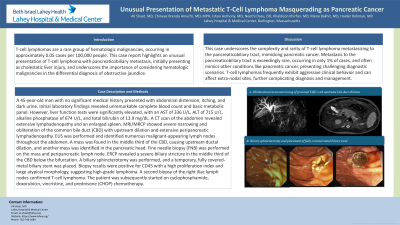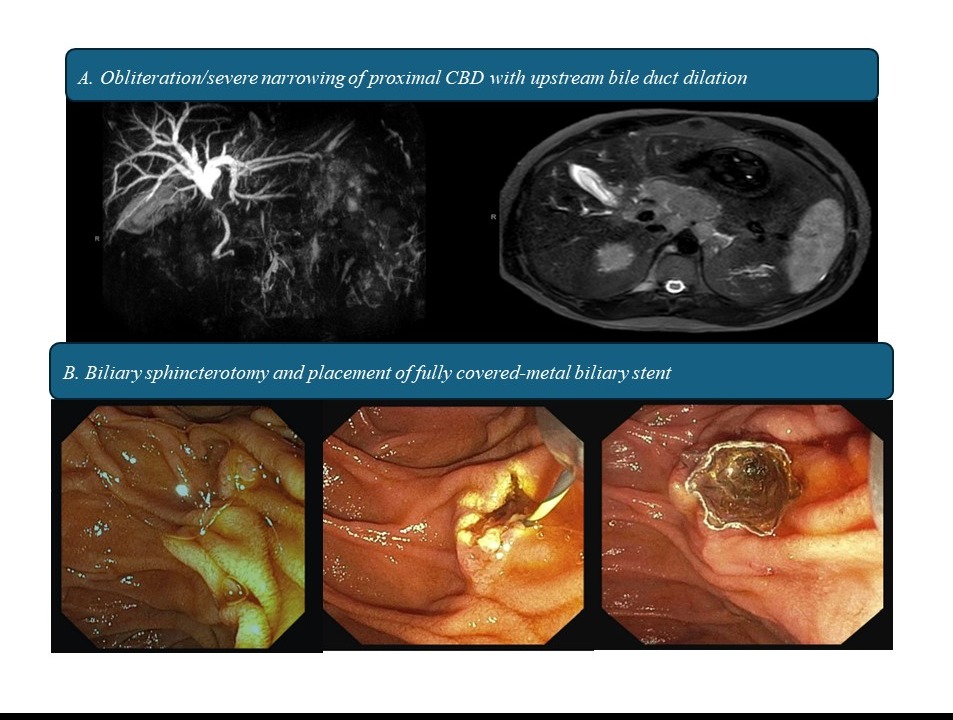Tuesday Poster Session
Category: Biliary/Pancreas
P3518 - Unusual Presentation of Metastatic T-Cell Lymphoma Masquerading as Pancreatic Cancer
Tuesday, October 29, 2024
10:30 AM - 4:00 PM ET
Location: Exhibit Hall E

Has Audio

Ali Shaat, MD
Lahey Hospital and Medical Center
Burlington, MA
Presenting Author(s)
Ali Shaat, MD1, Chineye Brenda Amuchi, MD, MPH2, Ishan Anthony, MD2, Neethi Dasu, DO2, Khaldoon Khirfan, MD2, Mena Bakhit, MD1, Haider Rahman, MD1
1Lahey Hospital and Medical Center, Burlington, MA; 2Beth Israel Lahey Health, Burlington, MA
Introduction: T-cell lymphomas are a rare group of hematologic malignancies, occurring in approximately 0.05 cases per 100,000 people. This case report highlights an unusual presentation of T-cell lymphoma with pancreaticobiliary metastasis, initially presenting as cholestatic liver injury, and underscores the importance of considering hematologic malignancies in the differential diagnosis of obstructive jaundice.
Case Description/Methods: A 45-year-old man with no significant medical history presented with abdominal distension, itching, and dark urine. Initial laboratory findings revealed unremarkable complete blood count and basic metabolic panel. However, liver function tests were significantly elevated, with an AST of 336 U/L, ALT of 715 U/L, alkaline phosphatase of 674 U/L, and total bilirubin of 13.9 mg/dL. A CT scan of the abdomen revealed extensive lymphadenopathy and an enlarged spleen. MRI/MRCP showed severe narrowing and obliteration of the common bile duct (CBD) with upstream dilation and extensive peripancreatic lymphadenopathy. EUS was performed and identified numerous malignant-appearing lymph nodes throughout the abdomen. A mass was found in the middle third of the CBD, causing upstream ductal dilation, and another mass was identified in the pancreatic head. Fine needle biopsy (FNB) was performed on the mass and peripancreatic lymph node. ERCP revealed a severe biliary stricture in the middle third of the CBD below the bifurcation. A biliary sphincterotomy was performed, and a temporary, fully covered-metal biliary stent was placed. Biopsy results were positive for CD45 with a high proliferation index and large atypical morphology, suggesting high-grade lymphoma. A second biopsy of the right iliac lymph nodes confirmed T-cell lymphoma. The patient was subsequently started on cyclophosphamide, doxorubicin, vincristine, and prednisone (CHOP) chemotherapy.
Discussion: This case underscores the complexity and rarity of T-cell lymphoma metastasizing to the pancreaticobiliary tract, mimicking pancreatic cancer. Metastasis to the pancreaticobiliary tract is exceedingly rare, occurring in only 1% of cases, and often mimics other conditions like pancreatic cancer, presenting challenging diagnostic scenarios. T-cell lymphomas frequently exhibit aggressive clinical behavior and can affect extranodal sites, further complicating diagnosis and management.

Disclosures:
Ali Shaat, MD1, Chineye Brenda Amuchi, MD, MPH2, Ishan Anthony, MD2, Neethi Dasu, DO2, Khaldoon Khirfan, MD2, Mena Bakhit, MD1, Haider Rahman, MD1. P3518 - Unusual Presentation of Metastatic T-Cell Lymphoma Masquerading as Pancreatic Cancer, ACG 2024 Annual Scientific Meeting Abstracts. Philadelphia, PA: American College of Gastroenterology.
1Lahey Hospital and Medical Center, Burlington, MA; 2Beth Israel Lahey Health, Burlington, MA
Introduction: T-cell lymphomas are a rare group of hematologic malignancies, occurring in approximately 0.05 cases per 100,000 people. This case report highlights an unusual presentation of T-cell lymphoma with pancreaticobiliary metastasis, initially presenting as cholestatic liver injury, and underscores the importance of considering hematologic malignancies in the differential diagnosis of obstructive jaundice.
Case Description/Methods: A 45-year-old man with no significant medical history presented with abdominal distension, itching, and dark urine. Initial laboratory findings revealed unremarkable complete blood count and basic metabolic panel. However, liver function tests were significantly elevated, with an AST of 336 U/L, ALT of 715 U/L, alkaline phosphatase of 674 U/L, and total bilirubin of 13.9 mg/dL. A CT scan of the abdomen revealed extensive lymphadenopathy and an enlarged spleen. MRI/MRCP showed severe narrowing and obliteration of the common bile duct (CBD) with upstream dilation and extensive peripancreatic lymphadenopathy. EUS was performed and identified numerous malignant-appearing lymph nodes throughout the abdomen. A mass was found in the middle third of the CBD, causing upstream ductal dilation, and another mass was identified in the pancreatic head. Fine needle biopsy (FNB) was performed on the mass and peripancreatic lymph node. ERCP revealed a severe biliary stricture in the middle third of the CBD below the bifurcation. A biliary sphincterotomy was performed, and a temporary, fully covered-metal biliary stent was placed. Biopsy results were positive for CD45 with a high proliferation index and large atypical morphology, suggesting high-grade lymphoma. A second biopsy of the right iliac lymph nodes confirmed T-cell lymphoma. The patient was subsequently started on cyclophosphamide, doxorubicin, vincristine, and prednisone (CHOP) chemotherapy.
Discussion: This case underscores the complexity and rarity of T-cell lymphoma metastasizing to the pancreaticobiliary tract, mimicking pancreatic cancer. Metastasis to the pancreaticobiliary tract is exceedingly rare, occurring in only 1% of cases, and often mimics other conditions like pancreatic cancer, presenting challenging diagnostic scenarios. T-cell lymphomas frequently exhibit aggressive clinical behavior and can affect extranodal sites, further complicating diagnosis and management.

Figure: CT and Endoscopy Images
Disclosures:
Ali Shaat indicated no relevant financial relationships.
Chineye Brenda Amuchi indicated no relevant financial relationships.
Ishan Anthony indicated no relevant financial relationships.
Neethi Dasu indicated no relevant financial relationships.
Khaldoon Khirfan indicated no relevant financial relationships.
Mena Bakhit indicated no relevant financial relationships.
Haider Rahman indicated no relevant financial relationships.
Ali Shaat, MD1, Chineye Brenda Amuchi, MD, MPH2, Ishan Anthony, MD2, Neethi Dasu, DO2, Khaldoon Khirfan, MD2, Mena Bakhit, MD1, Haider Rahman, MD1. P3518 - Unusual Presentation of Metastatic T-Cell Lymphoma Masquerading as Pancreatic Cancer, ACG 2024 Annual Scientific Meeting Abstracts. Philadelphia, PA: American College of Gastroenterology.
